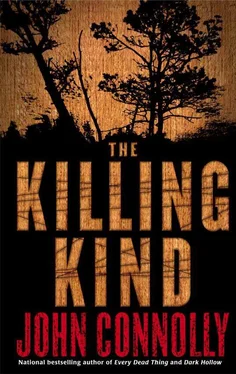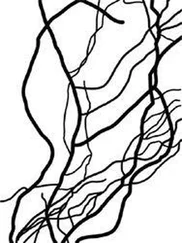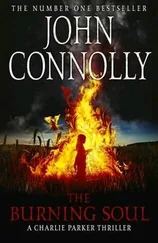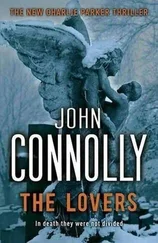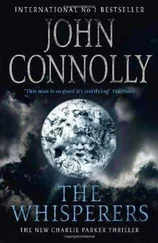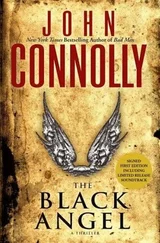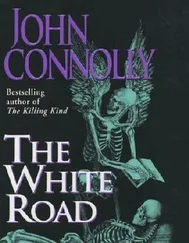I held the Smith amp; Wesson out at shoulder length from my body, gripping it by the trigger guard, then laid it gently on the ground before me. Lutz raised his bloodied head and stared dazedly at the bald man. I was gratified to see the look of fear that gradually spread across his face, but it was a small, fleeting pleasure. We were all at risk from this strange, hollow killer.
“Now I want you to remove the detective's shoes and socks.” I did as I was told, kneeling on Lutz's legs to keep him still. With a flick of his wrist, the Golem tossed me the rope. “Tie his legs together.”
Again, I knelt and tied him. All the while, Lutz was whispering to me: “Don't let him take me, Parker. I'll tell you what you want to know, just don't let him take me.”
The Golem heard him. “Be quiet, Detective. Mr. Parker and I have reached an accommodation.”
I saw Rachel moving behind the window, and shook my head slightly to indicate that she shouldn't get involved.
“Have we?” I asked.
“I will let you and your friend live, your girlfriend too, and you can take the young woman.” I should have known that nothing would get past this man. “I take Detective Lutz.”
“No!” shouted Lutz. “No way, man. He's going to kill me.”
I looked at the Golem, although I hardly needed confirmation that Lutz's fears were justified.
“Detective Lutz is correct,” he said, “but first he will tell me where to find his associates. Put him in the body bag, Mr. Parker, then you and your friend will carry the bag to my car.”
I didn't move. I wasn't prepared to give up Lutz without first learning what he knew.
“We both want the same thing,” I said. “We both want to find the people responsible for these deaths.”
The Jerichos both cocked simultaneously beneath his thumbs. There was to be no discussion.
After a struggle, we put Lutz in the body bag, stuck his socks in his mouth to silence him, and carried him down the road to where the Golem's Lincoln Continental stood. We opened the Continental's trunk and put Lutz inside before slamming the lid closed on him with the grim finality of a coffin lid being sealed. I could hear his muffled howls through the metal and the sound of his feet kicking against the sides of the trunk.
“Now, start walking back to the house, please,” said the Golem.
We stepped back and began walking slowly backward toward the house, never once taking our eyes off the bald man with the guns.
“I don't think we will be meeting again, Mr. Parker,” he said.
“I won't take it personally.”
He waited until we were fifty yards from the car, then walked quickly to the driver's door, got in, and drove away. Beside me, Louis released a long breath.
“That went well,” I said. “Although your professional reputation took something of a beating.”
Louis scowled. “You know, used to take me months to set up a hit. You give me five damn minutes. I ain't no James Bond.”
“Don't sweat it. He doesn't seem like the kind of guy who's going to tell.”
“Guess not. Man seemed like the strong, silent type.”
We walked quickly back to the house. Rachel came out onto the porch to meet us. The blood had drained from her face, and I thought that she was going to faint.
“Rachel?” I said, my hands gripping her shoulders. “What is it?”
She looked up at me.
“See for yourself,” she whispered.
I found Marcy Becker sitting in one of the big armchairs, her legs curled into her body. She was looking at the wall, tearing at one of her fingernails with her teeth. She glanced at me, then her eyes flicked to what lay on the floor before she returned her gaze quickly to the blank wall. We stayed in those positions for what seemed like a long, long time, until I felt Louis behind me and heard him swear softly as he saw what lay before us.
It was a book.
A book of bones.
A great book is like great evil
– CALLIMACHUS (C. 305-C. 240 B.C.)
THE BOOK WAS ABOUT FOURTEEN INCHES LONG and seven inches wide. Six small bones curled horizontally across its spine in three equidistant sets of two. They were slightly yellow and coated with some form of preservative that made them gleam in the sunlight. I wasn't certain, but I thought they might once have been the ends of ribs. They felt slick to the touch compared to the texture of the material upon which they lay. The cover of the book had been dyed a deep red, through which lines and wrinkles showed. Close to the top left-hand corner, a raised mole stood.
It was human skin. The hide had been dried, then sewn together in patches, using what appeared to be tendon and gut for stitching. When I moved my fingers gently over the cover, I felt not only the pores and lines of the dermis used to construct it but also the shapes of the bones that formed the framework beneath: radius and ulna, I suspected, and probably more ribs. It was as if the book itself had once been a living thing, skin over bone, lacking only flesh and blood to make it whole again.
There was no writing on either the cover or the spine, no indication of what the book might contain. The only marking was the cover illustration, Jansenist in style with its single central motif repeated in each of the four corners: a spider, indented in gold leaf, its eight legs curled inward to hold a single golden key.
Using only the tips of my fingers, I opened the book. Its spine was a human spine, held together with gold wire, the only material used that did not appear to have come from a human body. The pages had been attached to it using more tendon. The inside covers had not been dyed, and the differentiations in the pigments of the various skins used in its construction could be more clearly distinguished. From the top of the spine a bookmark curled down, constructed from lengths of human hair tightly bound, scavenged from bodies that, for reasons of discretion and concealment, could not be marked in more obvious ways.
There were about thirty pages of varying sizes in the book. Two or three were constructed from single patches of skin, twice as large as the book itself. These had been folded, then bound through the fold, creating a double page; other pages had been made up from smaller sections of skin sewn carefully together, some of them no bigger than two or three square inches. The pages varied in thickness; one was so thin that the color of my hand showed through beneath, but others were more thickly layered. Most appeared to be sections taken from the lower back or shoulders, although one page showed the strange sunken hole of a human navel and another bore, close to its center, a shrunken nipple. Like the bifolios of old, the parchments made from goatskin and calfskin used by medieval scribes, one side of the page was smooth where any remaining body hair had been rubbed off, while the other was rough. The smooth sides had been used for the illustrations and the script, so that on any one double page only the right-hand side was filled.
On page after page, in beautiful ornate script, were sections from the book of Revelation: some were complete chapters, others simply quotes used to elaborate upon the meaning of the illustrations contained in the book. The writing was Carolingian in origin, a version of the beautiful clear script inspired by the Anglo-Saxon scholar Alcuin of York, with each italic letter being given its own distinct but simple shape to aid legibility. Faulkner had worked around the natural flaws and holes of the skin, disguising them, where necessary, with a suitable letter or ornamentation. The capital letters on each page were uncials, each one an inch high and carefully created from hundreds of individual pen strokes. Animal and human grotesques cavorted around their bases and stems.
Читать дальше
